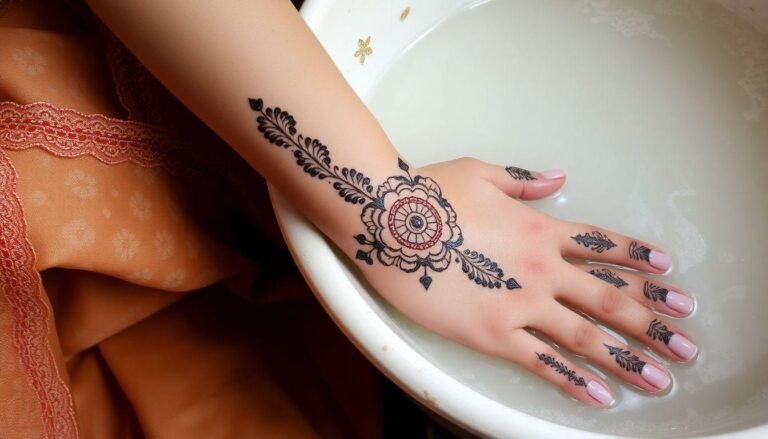Henna has been a beloved tradition for centuries, adorning hands and feet with intricate designs for celebrations and personal expression. But what happens when the party’s over and you need that beautiful stain gone faster than nature intended? Whether you’ve got a job interview coming up or just ready for a fresh canvas, knowing how to remove henna safely is essential. While natural fading takes 1-3 weeks, there are several effective methods to speed up this process without damaging your skin. Let’s explore safe henna removal techniques that work without harsh chemicals or painful scrubbing.
Why Henna Stains Last So Long
Before jumping into removal methods, it’s helpful to understand why henna sticks around in the first place. Henna contains a natural dye called lawsone that binds to the proteins in your skin cells, particularly the keratin. This creates that distinctive reddish-brown color that doesn’t wash away with regular soap and water. The dye actually penetrates the top layer of skin, which is why it fades gradually as your skin naturally exfoliates.
The darkness and longevity of henna depend on several factors:
Now let’s get into those removal methods you’ve been waiting for!
1. Salt Water Soak
One of the gentlest ways to fade henna is with a simple salt water solution. The salt acts as a mild exfoliant while also helping to break down the henna dye molecules.
How to do it:
This method works best when repeated daily, gradually lightening the stain with each application. It’s particularly effective for hands and feet that can be easily soaked.
2. Oil Cleansing Method
Oils can help dissolve the henna dye while also being kind to your skin. This method is especially good for larger areas where soaking isn’t practical.
Best oils to try:
Simply massage the oil into the hennaed area for 10-15 minutes, then wash with warm water and soap. The oil helps break down the dye while the massage action gently exfoliates. For best results, repeat this process daily.
3. Lemon Juice & Sugar Scrub
The natural acids in lemon juice work to lighten the henna, while sugar provides gentle exfoliation.
Mix 3 tablespoons of lemon juice with 3 tablespoons of sugar to create a paste. Gently scrub this mixture onto the hennaed area using circular motions for 5 minutes, then rinse with warm water. Be aware that lemon juice can make your skin more sensitive to sunlight, so apply sunscreen if you’ll be outdoors afterward.
4. Baking Soda Paste
Baking soda creates a mildly alkaline solution that can help fade henna more quickly.
Simple application:
This method can be slightly drying, so it’s important to follow up with a good moisturizer.
5. Swimming Pool Method
Have you noticed how henna fades faster when you’re on vacation? That’s because chlorinated water helps break down henna dye. If you have access to a swimming pool, spending 30-45 minutes swimming can significantly fade henna stains. The combination of chlorine and water immersion speeds up the process.
If you don’t have access to a pool, you can make a diluted chlorine solution at home—but be very careful as chlorine can be harsh on skin. Mix one part chlorine bleach with ten parts water, dip a cotton ball in the solution, and dab lightly on the henna. Rinse immediately and apply moisturizer afterward.
6. Toothpaste Technique
The mild abrasives in whitening toothpaste can help remove henna from smaller areas like fingers or toes.
Apply a layer of whitening toothpaste to the stained area and let it sit for 5-10 minutes. Use an old toothbrush to gently scrub in circular motions, then rinse with warm water. The combination of gentle abrasion and whitening ingredients helps fade the stain more quickly.
7. Hydrogen Peroxide Solution
For stubborn henna stains, a diluted hydrogen peroxide solution can be effective but should be used cautiously.
Mix equal parts 3% hydrogen peroxide and water. Using a cotton ball, apply to the stained area and let sit for 2-3 minutes before rinsing thoroughly. This method works by breaking down the dye molecules but can be drying, so always follow with moisturizer.
Prevention Tips for Future Applications
If you know you’ll need to remove henna quickly in the future, consider these preventative measures:
When to Exercise Caution
While these methods are generally safe, there are some situations where you should proceed with extra care:
With these seven methods in your beauty toolkit, you can say goodbye to unwanted henna stains without damaging your skin. Remember that patience is key—even with these techniques, complete removal takes time. Combining methods often works best, like following a salt soak with an oil massage.
The next time you enjoy beautiful henna art, you can do so with the confidence that you know how to safely remove henna from skin when you’re ready for a change. Whether you’re preparing for a job interview, special occasion, or just ready for fresh skin, these gentle yet effective techniques will help you transition back to your natural canvas.







